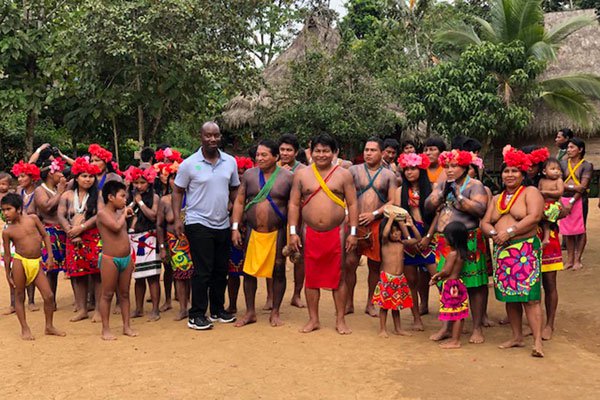Last year’s Christmas was one like no other. My family and friends ventured into the tropical rain forests of Chagres in Panama to share Christ’s birthday with the indigenous and enchanting Emberá Indian tribe. They have for more than 500 years defied modern living and influences choosing instead to live a simple, humble and dignified life deeply steeped in tradition and surrounded by Mother Nature.
Our journey to the Emberá forested nooks started on a motorised canoe steered by two young men dressed in colourful beads across their chests and loin cloths covering their front and back. Their youthful lean bronze bodies are decorated by some colorful ethnic paint and their heads sport long shiny hairs neatly tied in a ponytail. Both businesslike and speaking little, we learnt later that they are part of a traditional security network. The long canoe carved out of local wood had a capacity of eight passengers including our two hosts each protectively holding an oar. I guess it could serve as a weapon too.
Off and afloat
We set off into the enchanting wilderness on the San Juan De Pequeni river which joins Lake Alajuela. For some 40 minutes we were thrust into an amazing serene and tranquil environ punctuated by rickety sounds of the small engine, birds chirping, monkeys screeching as a thick green forest and vegetation whose leaves danced to gentle breezy winds.
As we floated across endless turns of crystal clear waters and penetrated the depth of even thicker forests, we were showered both by the splashes of the boat and sporadic rain forest drizzles. This heightened both the fear of the unknown and the anticipation of what lay ahead. What if the engine stopped? What if this was a trap? What if the canoe capsized?
The experience on the canoe and in the thickness of the forest was awesome – reminding me of the stories I read of the dark and often scary rivers of the Amazon, in Willaim Golding’s Lord of the Flies but also got some visualisation of what European adventurers such as Christopher Columbus must have experienced when they first visited this part of the world.
Meeting the culture
Phew! Before long we landed at a small site where we were welcomed by smiling and painted bare-chested women, donning fresh brilliant pink and yellow hibiscus on their foreheads and colourful beads around their necks. Emberá men bellowed tribal sounds, played distinctive drums and flutes. Their children, mimicking their parents’ outfits, looking healthy and cheerful were part of our welcome party.
We were immediately ushered into one large thatch roofed structure with long wooden stools on one side and tables filled with water, fruits, crafts and touristic art merchandise on the other. It is here that one of the senior Indian leaders, with the help of a translator, shared the history, culture and challenges of the Emberá peoples in the modern world.
Culinary delight
While we listened to him, we were served with an extraordinary Christmas lunch comprising a hot deep fried tilapia and plantain all wrapped in a fresh banana leaf. I doubt that I have eaten tastier fish. The Emberá diet consists of fruits, fish and plantain. As we devoured the tilapia we learnt that the Emberá tribe is uncompromising on marriage outside the tribe. Offenders become outcasts and may only visit the tribal community but not live amongst it.
The community has a code of conduct and is severe to deviants. Its leaders are elected using well respected traditional mechanisms. The nucleus Emberá family is largely monogamous with a family an average of five to six children. Men leave their families and are incorporated into and live with their wife’s family.
Spirituality
The Emberá are deeply spiritual. They believe in a God known as Ankorre and worship the earth, the sun and the moon. They believe that evil spirits roam the earth so their houses are elevated on stilts. They practice traditional healing based on native botanical medicines. They enjoy a life expectancy of 100 years. We were introduced to the chief midwife of the community who rose to salute us.
Beauty
The Emberá have no tradition of writing. Their history is orally passed on from one generation to the next. There is a lot to learn from them including their knowledge of botanical medicine, environmental protection, cultural preservation and governance.
Alas! The time we had was short and our visit ended with a ritual cultural dance and music where we all joined in a circular dance routine that involved mild shaking of the chest and bottom. The direction of the circular dance was often and abruptly changed catching many bewildered visitors out of step to the amusement of their hosts.
It was sad to say bye, thank you (bia bowa) and return to the real world but we had to leave these elegant and dignified people hoping and praying that they will survive and enjoy 2019 and many more Christmases in the paradise that is the Panama jungle.
Hot tip
The Emberá constitute the remnants of indigenous inhabitants of South America (about 33,000 in Panama and 50,000 in Columbia) whose land and livelihoods were overrun by European, mostly Spanish, colonisers, and have been thrust to the precarious margins of modern America.
